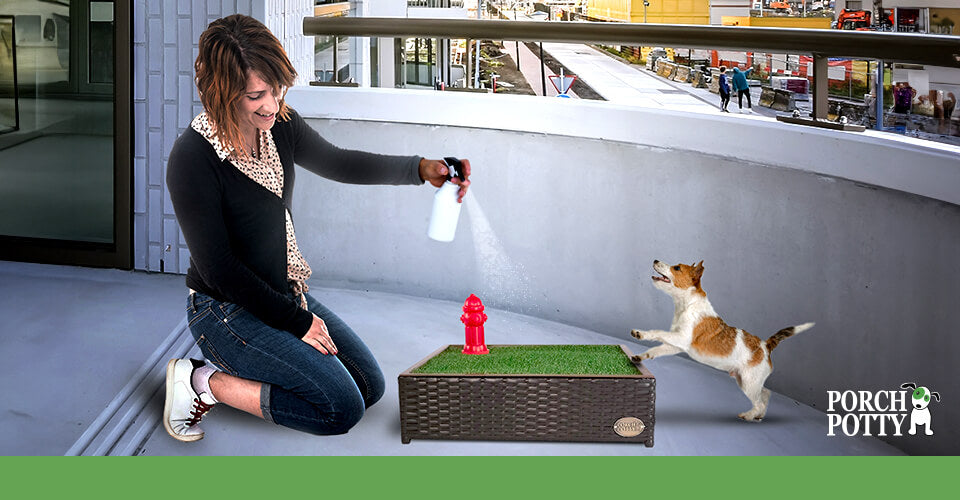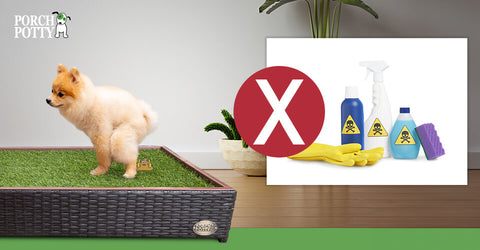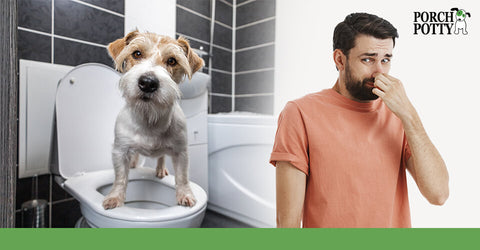
A dog owner sprays a Small Porch Potty with a gentle cleaner and odor eliminator to keep it fresh and clean.
Maintaining a clean and hygienic dog potty area is crucial for the health and happiness of both pets and their owners. A well-kept potty area not only prevents unpleasant odors and unsightly messes but also shields pets from harmful bacteria and parasites that can thrive in poorly maintained environments. Proper maintenance practices are essential, yet many pet owners inadvertently make mistakes that can compromise the effectiveness and cleanliness of these spaces. This article will delve into the five common mistakes made in maintaining dog potty areas and provide practical solutions to ensure these spaces remain sanitary and safe, thereby promoting a healthy and joyful living environment for our canine companions and their families.
1. Insufficient Cleaning
Neglecting regular and thorough cleaning of the dog potty area can cause unpleasant odors and bacteria growth, leading to discomfort for both the dog and potential health risks for the household. Insufficient cleaning not only creates an unwelcoming environment for your pet, possibly deterring them from using the area, but also increases the likelihood of infections and zoonotic diseases.
To counteract these issues, establishing a consistent cleaning routine is essential. Daily waste removal and weekly deep cleaning with pet-safe products can significantly reduce odors and prevent bacterial proliferation. Incorporating natural deodorizers like baking soda or vinegar can also help maintain a fresh environment without resorting to harsh chemicals. By maintaining a clean potty area, pet owners can ensure a healthier and nicer living space for their dogs and themselves.

Harmful chemicals not only risk damage to your Porch Potty, but can be harmful to your pets as well.
2. Using Harmful Chemicals
Using harsh chemicals to clean dog potty areas can inadvertently harm pets and the environment. These substances can cause skin irritations, allergies, and even poisoning in pets due to their sensitive nature and potential ingestion of chemical residues. Additionally, such chemicals can harm the environment by contaminating soil and water.
To mitigate these risks, it's advisable to use eco-friendly and pet-safe cleaning products that utilize natural ingredients, posing no harm to pets or the planet. Homemade solutions with vinegar, baking soda, and lemon juice also serve as effective, non-toxic alternatives for maintaining cleanliness and hygiene in potty areas. Opting for these safer cleaning methods ensures the well-being of pets and environmental health.
3. Ignoring Weather Conditions
Neglecting the impact of weather conditions like rain, snow, and extreme heat on dog potty areas can lead to increased maintenance challenges and discomfort for pets. Adverse weather can exacerbate cleanliness issues, making the area less appealing or even hazardous for dogs.
To address this, implementing weatherproofing measures is key. Protective covers can shield the area from precipitation, while proper drainage prevents water buildup. In hot weather, increasing cleaning frequency helps control odors and maintain hygiene. Adapting maintenance routines to suit the weather and utilizing weather-resistant materials can ensure the potty area remains accessible and safe for dogs throughout the year.
4. Overlooking Regular Maintenance
Regular maintenance of dog potty areas extends beyond just cleaning. It also involves monitoring for wear and tear and ensuring the space is secure and safe for pets. Failing to conduct these checks can lead to the deterioration of the potty area over time, reducing its functionality and lifespan. Additionally, overlooked maintenance issues can pose escape or injury risks for pets, especially if the area becomes unsafe due to damaged components or weakened enclosures.
To prevent these problems, pet owners should adopt a comprehensive maintenance routine. This routine could include monthly inspections for signs of wear on artificial turf or fencing, checking drainage systems for clogs, and ensuring that all gates or barriers are intact and secure. Setting up a replacement schedule for parts that are worn out or broken is also crucial. By adhering to a detailed maintenance checklist, owners can ensure the longevity and safety of the dog potty area, keeping it a reliable and secure space for their pets to use.

It is imperative, both for your sensory comfort and health, to neutralize and combat odors around your dog's potty area.
5. Neglecting Odor Control
Ignoring odor control in dog potty areas can quickly turn them into unpleasant and unhealthy spaces. Without proper management, odors can permeate outdoor and indoor environments alike, creating an uncomfortable living situation for both pets and their owners. Moreover, strong odors can attract pests, further degrading the cleanliness and safety of the area.
Effective solutions for combating odors include the use of odor neutralizers specifically designed for pet waste, which can break down and eliminate odors at the source. Ensuring proper ventilation, especially for indoor potty areas, is critical in dispersing any lingering smells. Additionally, selecting the right type of absorbent materials, such as high-quality artificial turf or absorbent pads that are easy to clean and replace, can significantly reduce odor buildup. By implementing these strategies, pet owners can maintain a fresh and healthy potty area, making the space more inviting for pets and more pleasant for everyone in the home.
In the journey of pet ownership, maintaining a clean and hygienic dog potty area is foundational to ensuring the health and happiness of our furry companions and their human families. Avoiding common mistakes such as insufficient cleaning, using harmful chemicals, ignoring weather conditions, overlooking regular maintenance, and neglecting odor control is crucial. A well-maintained potty area not only prevents health risks and discomfort but also contributes significantly to a harmonious living environment. By adopting the solutions outlined, pet owners can ensure their dogs have a safe, pleasant, and welcoming space to relieve themselves, which is essential for their well-being and the cleanliness of the home.
We encourage our readers to share their own experiences and tips for maintaining an effective dog potty area in the comments section below. Your insights could greatly benefit others in our community! Additionally, for those seeking further resources and innovative products to enhance their pet care routines, visiting PorchPotty.com offers a wealth of information and solutions tailored to meet the needs of dogs and their owners. Let's work together to create the best possible environments for our pets, ensuring they are as healthy and happy as they make us.
For more information on potty training your dog, check out these articles:
12 Steps to Porch Potty Success
The Ultimate Guide to Potty Training Your Puppy: When, How, and the Magic of Porch Potty
Maximizing Outdoor Time: Porch Potty for Apartment-Dwelling Dog Owners



